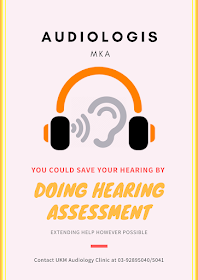NEWBORN HEARING SCREENING (NHS)
WHAT?NEWBORN HEARING SCREENING?
Have you heard about newborn hearing screening? Many develop country such as America and United Kingdom have done Universal Newborn Hearing Screening as their compulsory task before the parent and their babies can go home.
In Malaysia, many hospital has started this screening program such Universiti Kebangsaan Medical Centre (UKMMC), most of general hospital as well as private hospital (Prince Court Hospital).
WHY DO WE NEED TO SCREEN YOUR BABIES HEARING?
Have you see children use sign language as a tool for communication to the others? YES or NO?
Thus, the reason is to get early identification of hearing loss among the newborn babies as well as give early intervention in order to provide babies better chances to develop their speech and language skills.
The goal of early hearing detection and intervention (EHDI)
is to maximize linguistic and communicative competence and literacy development
for children who are deaf or hard of hearing. (JCIH, 2007).
Please read JCIH Effective Summary 2007 to know detail about the principal of newborn hearing screening. Click here.
I HAVE SUMMARIZE THE PRINCIPLES OF UNHS BASED ON JCIH, 2007:
1) All infants below 1 month old need to undergo physiologic hearing screening.
2) If the infant did not pass for the first hearing screening, they need to undergo second hearing screening before 3 months of age in order to confirm the presence of hearing loss.
3) All infants with detected permanent hearing loss should receive intervention services before 6 months of age.
4) The early hearing detection and intervention should be family centered.
5) The child with permanent hearing loss should have immediate access to hearing aids or any other assistive listening devices (FM system).
6) All infants should be monitored for hearing loss at home.
7) All infants with confirmed hearing loss should have appropriate interdisciplinary intervention program.
8) Information system should be used to measure outcomes of effectiveness of EHDI.
Reference:
Executive Summary Of Joint Committee On Infant Hearing Year
2007 Position Statement: Principles and Guidelines for Early Hearing Detection
and Intervention Programs





















